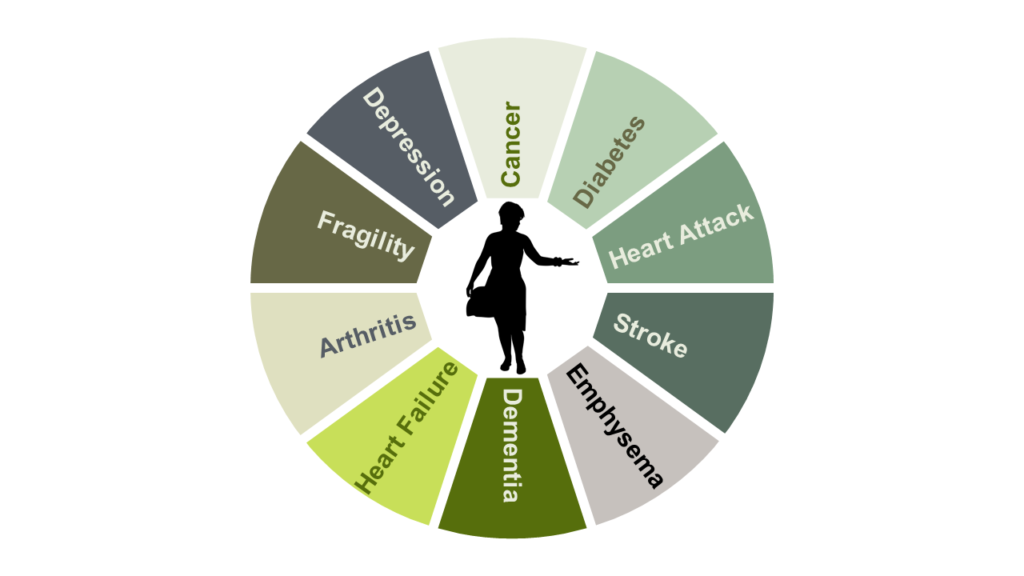Successful Aging

Take Home Message
1. Over the last century, modern medicine has increased the average life expectancy from 50 years to 82 years.
2. Our longer lives have led to dramatic increases in global rates of age-related diseases.
3. You can delay age-related disease and disability until the very end of life, a phenomenon known as Successful Aging.
4. The science of aging has developed strategies that can help you age successfully.
Normal versus Successful Aging

The rapid rise of modern medicine in the 20th century gave a gift to humanity: 30 years of extra life 1,2. Compared to a meager 45 years in 1900, the average life expectancy for citizens in developed countries is now around 82 years 1,2.
This is thanks to advances in sanitation, nutrition, and the prevention and treatment of infectious diseases.
Unfortunately, your body was not designed to live forever. As you age, you become increasingly vulnerable to the indignities and diseases associated with growing old (Figure 1). The average person experiences 72 years of healthy life followed by ten miserable years of disability and chronic disease.
Can you age successfully?
Are you doomed to a decrepitude? Researchers from the field of Geroscience (the science of aging) say no.
Over 40 years ago Dr. James Fries argued that your life could be ‘physically, emotionally, and intellectually vigorous until shortly before its close’ 5.
This was a radically different point of view from the conventional wisdom of the day, which claimed that lifespan extension inevitably caused increased disability and chronic disease 6.
Modern researchers have refined Dr Fries’ pioneering ideas into the concept of successful aging. The purpose of successful aging is to increase the period of your life lived with 1) a high cognitive and physical capacity, 2) strong emotional and psychological health and 3) an active engagement in life 7, 8.
The good news is that evidence suggests that successful aging is possible for most people, including you.
Evidence from Centenarians
The potential of successful aging is clearly demonstrated by centenarians (individuals who live for over one hundred years) who display very good health until just before death 9. This phenomenon proves that for some, successful aging is indeed achievable.
However, around 30% of the ability of centenarians to live a long healthy life is genetic 10,11. Thus, it is unclear whether successful aging in centenarians is due to good genes, a healthy lifestyle, or both.
Evidence from Seventh Day Adventists
Of much greater relevance to you are studies showing that individuals who practice a healthy lifestyle also age successfully 12,13.
The best example is Californian Seventh-Day Adventists. Most Seventh Day Adventists are non-smokers, don’t drink alcohol, and avoid caffeine 3. A small percentage of Adventists are vegans, others follow a lacto-ovo-vegetarian diet, and approximately half choose omnivorous diets that are low in meat consumption 3.
Healthy Living Reduces Death and Disease
Early studies showed that Seventh Day Adventists have lower risks for cancer, cardiovascular disease, diabetes and live longer than the general population 4,14.
A more recent study compared 383,600 people from the general population with 86,610 Seventh Day Adventists 3. The large sample sizes of the study allowed the researchers to accurately account for the effects of education, past smoking habits, age, region of residence, sex 3.
The most important findings from this study are that Seventh Day Adventists display 1) significantly lower rates of all-cause mortality and 2) a decreased incidence of all cancers 3.
Importantly, the study confirms that healthy lifestyle interventions are efficacious across both race and sex 3. What’s most striking of all is that Seventh Day Adventists enjoy both an extended healthspan and an increased lifespan compared to most people 3,4.
Healthy Living Improves Mental Health
Further, it appears that Seventh Day Adventists also enjoy better mental health than the general population 15.
Whereas the general population shows an increase in depression associated with age 15, Seventh Day Adventists continue to improve their mental health from the ages of 55 to 74 years old, and mental health remains high even in the very old Adventists population 15. Importantly, this trend also holds true across sex and race 15.
The Bottom Line
While mortality remains a brute fact of our existence, the science of aging shows that we may be able to increase our lifespan and delay age-related physical and mental decline using simple and safe lifestyle interventions. More recent studies have begun to identify the key lifestyle interventions that can help most people age successfully.
For more information, please download our FREE Guide to Successful Aging!
GUIDE TO SUCCESSFUL AGING FREE DOWNLOAD
References and Further Reading
1 Riley, J. C. Rising life expectancy: a global history. (Cambridge University Press, 2001).
2 WHO. World health statistics 2015. (World Health Organization, 2015).
3 Fraser, G. E., Cosgrove, C. M., Mashchak, A. D., Orlich, M. J. & Altekruse, S. F. Lower rates of cancer and all-cause mortality in an Adventist cohort compared with a US Census population. Cancer 126 (2020).
4 Fraser, G. E. & Shavlik, D. J. Ten years of life: Is it a matter of choice? Arch Intern Med 161, 1645-1652 (2001).
5 Fries, J. F. Aging, natural death, and the compression of morbidity. N Engl J Med 303, 130-135 (1980).
6 Gruenberg, E. M. The failures of success. 1977. Milbank Q 83, 779-800 (2005).
7 Kaeberlein, M. How healthy is the healthspan concept? Geroscience 40, 361-364, (2018).
8 Rowe, J. W. & Kahn, R. L. Successful aging. The Gerontologist 37, 433-440 (1997).
9 Fillit, H. M., Rockwood, K. & Young, J. B. Brocklehurst’s textbook of geriatric medicine and gerontology e-book. (Elsevier Health Sciences, 2016).
10 Sebastiani, P. et al. Genetic signatures of exceptional longevity in humans. PLoS One 7 (2012).
11 Brooks-Wilson, A. R. Genetics of healthy aging and longevity. Human genetics 132, 1323-1338 (2013).
12 Breslow, L. & Enstrom, J. E. Persistence of health habits and their relationship to mortality. Prev Med 9, 469-483 (1980).
13 Breslow, L. & Breslow, N. Health practices and disability: some evidence from Alameda County. Prev Med 22, 86-95 (1993).
14 Beeson, W. L., Mills, P. K., Phillips, R. L., Andress, M. & Fraser, G. E. Chronic disease among seventh‐day adventists, a low‐risk group. Rationale, methodology, and description of the population. Cancer 64, 570-581 (1989).
15 Lee, J. W. et al. Cohort profile: The biopsychosocial religion and health study (BRHS). Int J Epidemiol 38, 1470-1478 (2009).
Disclaimer
The material displayed on this website is provided without any guarantees, conditions or warranties as to its accuracy.
Information written and expressed on this website is for education purposes and interest only. It is not intended to replace advice from your medical or healthcare professional.
You are encouraged to make your own health care choices based on your own research and in conjunction with your qualified practitioner.
The information provided on this website is not intended to provide a diagnosis, treatment or cure for any diseases. You should seek medical attention before undertaking any diet, exercise, other health program or other procedure described on this website.
To the fullest extent permitted by law we hereby expressly exclude all warranties and other terms which might otherwise be implied by statute, common law or the law of equity and must not be liable for any damages whatsoever, including but without limitation to any direct, indirect, special, consequential, punitive or incidental damages, or damages for loss of use, profits, data or other intangibles, damage to goodwill or reputation, injury or death, or the cost of procurement of substitute goods and services, arising out of or related to the use, inability to use, performance or failures of this website or any linked sites and any materials or information posted on those sites, irrespective of whether such damages were foreseeable or arise in contract, tort, equity, restitution, by statute, at common law or otherwise.

Ten Minutes is All You Need
Research has shown that ten minutes of moderate-to-vigorous exercise performed each day is enough to significantly reduce your risk of early death.

How to Sprint Safely
Healthy adults can sprint safely if they build a strong aerobic and strength base, strengthen their hamstring and calf muscles, and apply a sub-maximal approach to sprint training.




